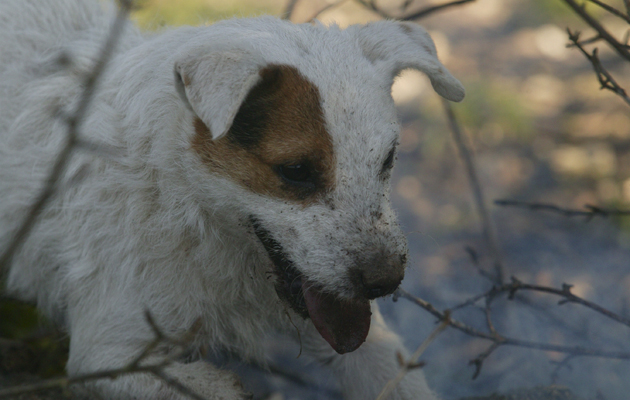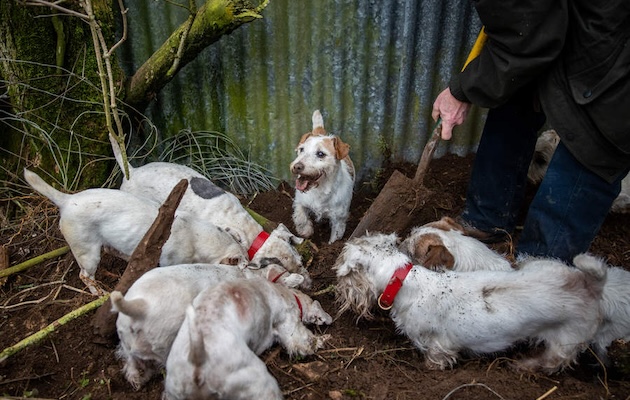Ratting with terriers offers a traditional check to the rise of the poison-resistant super rat. But which terrier is the best ratter?
Ratting with terriers – which terrier is best for the job?
The Border terrier holds sway in the north while Parson Jack Russell’s terrier has a loyal following in the West Country.
According to David Hancock, in his authoritative Sporting Terriers: Their Form, Their Function and Their Future, Russell “favoured a terrier with length of leg, a narrow chest, a well-boned skull and a thick, hard, dense, close-lying coat”. Of the Border, Hancock writes, “There is in the expression of a Border terrier an implacable determination which is seen in no other breed.” (Read the history of terriers by Sir Johnny Scott.)
Ratting with terriers – will any terrier do?
What is certain, where ratting with terriers is concerned, is that any terrier may be employed so long as it is fast, agile, strong, has stamina and is quick in its work.

Patterdale terriers are fast and formidable ratting dogs.
This might include ratting with terriers such as the Lucas or Lakeland breeds to Sealyham and Skye terriers as well as whippets. Bedlington terriers, named after the Northumbrian village of their origin, were once champions of vermin control.
In the 19th century, smooth-coated, black-and-tan Manchester terriers, now rare, were famous in the London rat pits frequented by Lord Byron and the Duke of Wellington.
Celebrated was the 26lb bulldog Billy that, on 22 April 1823, slew 100 rats in five-and-a-half minutes in the Westminster pit. Queen Victoria had her own ratcatcher, Jack Black, who sported a coat with VR on the lapels and kept rats in his stove hat. (Read terriers at the top – small dogs in stately homes.)
“Any self-respecting canine will catch rats, though terriers and small lurchers are probably the best,” says David Harcombe, editor of Earth Dog – Running Dog and several volumes of memoirs, entitled A Terrierman’s Life. “I have seen a miniature long-haired dachshund do a decent job on rats in yards and fields, and that was just a Kennel Club, toy-bred thing. They would not be good for killing rats in large numbers, however.”
The brown rat

A brown rat. In 1919 The Field reported on National Ratting Week. They recorded the rat population at 43 million.
In 1919, The Field reported on National Rat Week, promoted by the Board of Agriculture and Fisheries, where it was estimated that the UK rat population was around 43 million.
Corn barns, chicken sheds and hayricks are the traditional feeding grounds and dwelling places of the brown rat. Sometimes it is necessary to smoke them out by attaching a hose to an old motorbike exhaust or chain saw (minus the chain) and putting it down a hole. (Read more on the Jack Russell terrier.)

Smoking out the rat so the terriers can make the kill.
Rat poison
Rat poison has changed little since the Fifties (essentially red and blue dressed corn). These poisons are increasingly ineffective as the rats build up immunity to them. You still can’t beat the traditional method of trapping them with terriers.

A terrier at the ready for ratting.
Which terrier makes the best ratter?

Which terrier does it best? These terriers share the kill.
Welsh writer Brian Plummer, who made a lifelong study of rat hunting and had a terrier of his own breeding named after him, chronicled his lifelong fascination with vermin in Tales of a Rat-Hunting Man (1978). Plummer was an itinerant ratcatcher and storyteller brought up in a mining village near Bridgend in the late Forties. His fox terrier/Sealyham/bull terrier cross dog was put to work in the coal slacks, rubbish tips and pigsties of the Valleys, earning money and a reputation as a rat killer.
“The Sealyham blood in them gave them strength of jaw, the Bedlington blood endowed them with incredible agility and the bull terrier blood, the real old fighting blood, gave them that little ‘extra something’ that made them impervious to pain,” he believed.
Of all the many terriers that Plummer bought or bred, one, Sam, he called the love of his life. “He was a hideous hotchpotch of every game terrier that the mining folk in my valley could lay their hands on. His ears were cropped to the head as a result of clashes with fox and badger, and his body was shredded with numerous old wounds.” Sam was the result of assorted breeding that included a great-great-grandfather that had been a fighting bull terrier, which was mated to a Bedlington terrier from the Cheviot Hills (that had once killed a half-grown pig) and this, in turn, was mated to a Sealyham. “He was the result of assorted breeding,” wrote Plummer. “Most Russell terriers of today have similar dubious ancestries.”
Plummer offers specific observations about what makes a good ratter. Borders, he says, are slow to “enter” to rat and Jack Russells work best on their own as they are jealous hunters and prone to attack strange dogs. Lakeland terriers, he feels, make the ideal first ratting terrier, dynamic, game and quick to mature, and he once trained a dandie dinmont, the massive jaws of which reduced rats to pulp.
Tenacity of terriers
The intelligence and tenacity of terriers should not be underestimated and success does not always have to be measured in numbers. “The character of the dog is all important,” says Hancock. “People can argue about length of leg and the like but, in my view, what matters is prey-drive and determination.”
This article was originally published in 2015 and has been updated.





